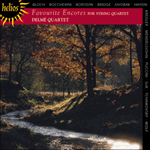
Welcome to Hyperion Records, a British classical label devoted to presenting high-quality recordings of music of all styles and from all periods from the twelfth century to the twenty-first.
Hyperion offers both CDs, and downloads in a number of formats. The site is also available in several languages.
Please use the dropdown buttons to set your preferred options, or use the checkbox to accept the defaults.

The first movement’s opening bravura trills from the first cello set the scene for a display of cello fireworks throughout the whole work, which never sacrifices lyricism for mere showing off. The ‘trotting music’ that re-appears in many of Boccherini works conjures up the scenic, mountainous journeys to and from Madrid. The minuet, placed second, starts in optimistic mood but the trio brings a pall of sadness through a reflective soliloquy for the first cello in the minor key. The Grave is a place of tranquillity among the other three movements, all marked con moto. The intimacy of the music in this movement is of a purity and serenity that is so tender as to be almost unbearable. It demands the well-known rondeau that follows as a ‘tiramisu’; dispelling any notion of self-indulgence, it celebrates the recurrent nature of life itself.
from notes by Keith Pascoe © 2003
Le premier mouvement s’ouvre par des trilles pleins de bravoure au premier violoncelle, un climat propice aux éclats pyrotechniques du violoncelle ; si ceux-ci abondent durant toute l’œuvre, jamais le lyrisme ne leur est sacrifié. La musique aux allures de « trot » qui réapparaît dans de nombreuses œuvres de Boccherini, évoque les paysages montagnards de ses aller-retour à Madrid. Le menuet, placé en seconde position, débute avec optimisme mais le trio engendre un voile de tristesse à travers le soliloque pensif en mineur du premier violoncelle. Le Grave est un havre de tranquillité parmi les trois mouvements tous notés con moto. L’intimité de la musique de ce mouvement est d’une pureté et d’une sérénité dévoilant une tendresse presque insoutenable. Le fameux rondeau qui s’ensuit est bien nécessaire, à la manière d’un « tiramisu » ; dispersant toute notion de laisser-aller, il célèbre la nature récurrente de la vie même.
extrait des notes rédigées par Keith Pascoe © 2003
Français: Isabelle Battioni
Die Bravourtriller des ersten Cellos am Anfang des ersten Satzes geben den Rahmen für ein Werk voller Cello-Feuerwerk, wobei das bloße Brillieren die Lyrik jedoch nie verdrängt. Die „trottende Musik“, die in vielen Werken Boccherinis vorkommt, beschwört die malerischen Bergtouren von und nach Madrid herauf. Das Menuett, der zweite Satz, beginnt optimistisch, das Trio jedoch sorgt mit einem nachdenklichen Monolog des ersten Cellos in der Molltonart für einen traurigen Touch. Das Grave ist eine Insel der Ruhe inmitten der anderen drei Sätze, die alle mit con moto überschrieben sind. Die Intimität der Musik dieses Satzes ist von einer so zarten Reinheit und Ruhe, dass es kaum zu ertragen ist. Das bekannte, darauf folgende Rondeau ist als „Tiramisu“ förmlich notwendig: indem es jegliche Anwandlung von Maßlosigkeit zerstreut, zelebriert es die wiederkehrende Natur des Lebens.
aus dem Begleittext von Keith Pascoe © 2003
Deutsch: Viola Scheffel
 Favourite Encores for string quartet Favourite Encores for string quartet‘How many string quartets play encores? Those that don't should have a listen to the Delmé Quartet's highly entertaining selection. The playing is exc ... ‘This is quite magnificent’ (CDReview)» More |

